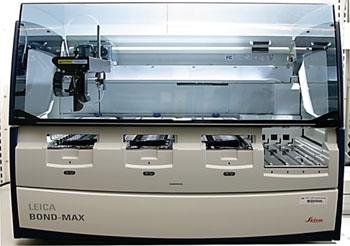Minimally Invasive Test Identifies Patients with Reflux Symptoms
By LabMedica International staff writers
Posted on 17 Feb 2015
A new, minimally invasive cell sampling device coupled with assessment of trefoil factor 3 expression can be used to identify patients with reflux symptoms who warrant endoscopy to diagnose Barrett's esophagus.Posted on 17 Feb 2015
Barrett's esophagus (BE) is a commonly undiagnosed condition that predisposes to esophageal adenocarcinoma and routine endoscopic screening for BE is not recommended because of the burden this would impose on the health care system.

Image: The BOND-MAX fully automatic immunochemistry stainer (Photo courtesy of Leica).
Scientists at the Medical Research Council Cancer Unit (Cambridge, UK) collaborating with colleagues from other British institutions, enrolled 463 individuals attending 11 UK hospitals for investigational endoscopy for dyspepsia and reflux symptoms as controls, and 647 patients with Barrett's esophagus who were attending hospital for monitoring endoscopy. Before undergoing endoscopy, the study participants swallowed a Cytosponge so that the researchers could evaluate the safety, acceptability, and accuracy of the Cytosponge- Trefoil Factor 3 (TFF3) test for the diagnosis of Barrett's esophagus compared with endoscopy.
Anonymized samples from the Cytosponge were processed to paraffin blocks and cut into consecutively numbered sections. Immunostaining was carried out on slides two and 15 for TFF3 using a proprietary monoclonal antibody (BD Diagnostics; Durham, North Carolina, USA) using standard protocols on a BOND-MAX autostainer (Leica Biosystems; Newcastle upon Tyne, UK).
The team found that the new test correctly identified 79.9% of the 647 individuals with endoscopically diagnosed Barrett's esophagus, and that 92.4% of 463 individuals unaffected by Barrett's esophagus were correctly identified as being unaffected. The sensitivity of the test increased to 87.2% for patients with circumferential Barrett's segments more than three cm, which are known to confer a higher cancer risk. Nearly 94% of the participants swallowed the sampling device (Cytosponge) successfully, there were no adverse effects attributed to the device, and participants who swallowed the device generally rated the experience as acceptable.
The authors concluded that the Cytosponge-TFF3 test can diagnose Barrett's esophagus in a manner that is acceptable to patients and logistically feasible across multiple centers. This test may substantially lower the threshold for investigating patients with reflux, as part of a strategy to reduce population mortality from esophageal adenocarcinoma. The study was published on January 29, 2015, in the journal Public Library of Science Medicine.
Medical Research Council Cancer Unit
BD Diagnostics
Leica Biosystems













